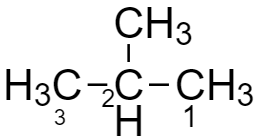
What is the chain isomer of ${C_4}{H_{10}}$?
Answer
574.2k+ views
Hint: If two or more compounds have the same molecular formula but different chemical and physical properties they are called isomers and the phenomena is known as isomerism.
Complete step by step answer:
Isomerism is of two types:
-Structural isomerism
-Stereoisomerism
If the compound has the same molecular formula but different structures i.e., different arrangements of atoms within the molecule are called structural isomers and the phenomena is known as structural isomerism. Whereas the compounds having the same structural formula but have a different relative arrangement of atoms or groups in space are called stereoisomers and the phenomena are known as stereoisomerism.
Structural isomers are of six types. Chain isomers are part of structural isomers and are defined as the compounds that have the same molecular formula but a different arrangement of the carbon chain within the molecule. They are also known as nuclear isomers and the phenomena is known as chain isomerism or nuclear isomerism.
The given compound is Butane and its chain isomer is isobutene, hence there are two chain isomers and the structures for them is given below:

The IUPAC name of isobutane is 2-methylpropane and the structure is given below:

Here the first isomer i.e. n-butane is a straight-chain compound with four carbon atoms bonded with the single covalent compound. In another isomer i.e. isobutane there are three carbon atoms in the parent chain and one in the side-chain as a methyl group.
Note: Both compounds butane and isobutene occur in natural gas and crude oil. Both compounds are formed in large quantities in the refining of petroleum to produce gasoline. But in the terms of vapour pressure isobutane due to its structure far superior to n-butane.
Complete step by step answer:
Isomerism is of two types:
-Structural isomerism
-Stereoisomerism
If the compound has the same molecular formula but different structures i.e., different arrangements of atoms within the molecule are called structural isomers and the phenomena is known as structural isomerism. Whereas the compounds having the same structural formula but have a different relative arrangement of atoms or groups in space are called stereoisomers and the phenomena are known as stereoisomerism.
Structural isomers are of six types. Chain isomers are part of structural isomers and are defined as the compounds that have the same molecular formula but a different arrangement of the carbon chain within the molecule. They are also known as nuclear isomers and the phenomena is known as chain isomerism or nuclear isomerism.
The given compound is Butane and its chain isomer is isobutene, hence there are two chain isomers and the structures for them is given below:

The IUPAC name of isobutane is 2-methylpropane and the structure is given below:

Here the first isomer i.e. n-butane is a straight-chain compound with four carbon atoms bonded with the single covalent compound. In another isomer i.e. isobutane there are three carbon atoms in the parent chain and one in the side-chain as a methyl group.
Note: Both compounds butane and isobutene occur in natural gas and crude oil. Both compounds are formed in large quantities in the refining of petroleum to produce gasoline. But in the terms of vapour pressure isobutane due to its structure far superior to n-butane.
Recently Updated Pages
Why are manures considered better than fertilizers class 11 biology CBSE

Find the coordinates of the midpoint of the line segment class 11 maths CBSE

Distinguish between static friction limiting friction class 11 physics CBSE

The Chairman of the constituent Assembly was A Jawaharlal class 11 social science CBSE

The first National Commission on Labour NCL submitted class 11 social science CBSE

Number of all subshell of n + l 7 is A 4 B 5 C 6 D class 11 chemistry CBSE

Trending doubts
Differentiate between an exothermic and an endothermic class 11 chemistry CBSE

10 examples of friction in our daily life

One Metric ton is equal to kg A 10000 B 1000 C 100 class 11 physics CBSE

Difference Between Prokaryotic Cells and Eukaryotic Cells

State the laws of reflection of light

Explain zero factorial class 11 maths CBSE




